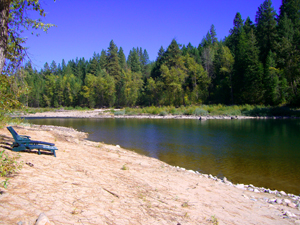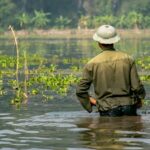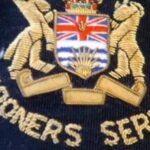KETTLE RIVER Q&A: Hitting the ground running
It’s often a concern when environmental plans are completed that they will do little more than sit on a shelf. Thanks to the leadership and dedication of the Regional District of Kootenay Boundary and many other project partners, the Kettle River Watershed Management Plan has ‘hit the ground running’ and has a number of exciting projects underway and in the works.
At their first meeting of the implementation phase, the Steering Committee for the Watershed Management Plan recently reviewed ideas of how to coordinate the many aspects of implementation over the next three years. “This stage is really exciting,” said Rolly Russell, Director for Area D / Rural Grand Forks and Chair of the Implementation Team. “After all the dialogue over the past few years, now we’re making things happen. To me, this is where the fun work starts – where we start doing, guided by a great deal of diverse thought and dialogue!”
“When you think back to where we were three years ago, you realize how far we have come, with a report based on strong consultation with a cross section of the community,” said Marguerite Rotvold, who has represented the Village of Midway on the Steering Committee since 2010.
“Implementing the strategies in this plan is also consistent with the high priority given by West Boundary residents to protecting the health of the environment in the broad community survey,” said Vicki Gee, RDKB Director for Area E / West Boundary.
At the RDKB, the Plan will be used to inform a wide variety of decisions that have an impact on water. “I’m looking forward to using the plan when we consider development applications and land use planning,” said Donna Dean, Manager of Planning and Development for the RDKB. “It’s really a lens to help consider and decrease the impacts on water from all kinds of activities.”
Implementation of the Plan will also enable residents of all parts of the Boundary to work ‘hands-on’ on water conservation, stream bank restoration, or other projects. “As this plan rolls out, there will be so many opportunities for communities to work on individual projects that will showcase what we can do together as a region,” said Grace McGregor, Chair of the Steering Committee and the RDKB Board of Directors.
Several projects are already moving from plans to reality this year. Habitat restoration projects are being planned for Beaverdell, Christian Valley, and the Upper Granby to support recovery of the endangered Speckled Dace minnow, thanks to grants from Environment Canada’s Habitat Stewardship Program for Species at Risk and the Okanagan Chapter of Trout Unlimited Canada. The Christina Lake Stewardship Society is planning a lakeshore restoration demonstration and native plant nursery, and funding proposals have been submitted for bank stabilization and fish habitat improvement on the Kettle River beside the historic Sion Cemetery west of Grand Forks.
A plan is being developed to bring together all of the water suppliers in a water conservation strategy and education program, and a ‘learning garden’ at the Grand Forks Aquatic Centre will demonstrate water conservation, soil improvement, and an ecological landscape design system called ‘permaculture’.
In a telephone interview, Rick Simpson, who represented BC Wildlife Federation and the Grand Forks Wildlife Association on the Stakeholder Advisory Group, emphasized the long-term commitment required: “This watershed plan will need to be here for a long time, and we’ll need to keep the continuity of effort and leadership that has been given so far – and that is really founded on a wide network in the community that care for the watershed and want to do right by it.”
Simpson is speaking of volunteers like Brad Siemens of the Grand Forks Wildlife Association, who for two years has taken us on river tours to look at fish habitat conditions. I also think of community members from many different organizations who clean up riverbanks and backroads, monitor fish and bird populations, or raise substantial funds for conservation and restoration.
As the coordinator for the planning process and now implementation I am truly excited to continue working with this great network of people to move the Plan to reality, and look forward to meeting with you in the field or in the board room as part of the many projects going forward.
Graham Watt is Coordinator of the Kettle River Watershed Management Plan for the Regional District of Kootenay Boundary, and can be reached at plan@kettleriver.ca / 250.442.4111.


























